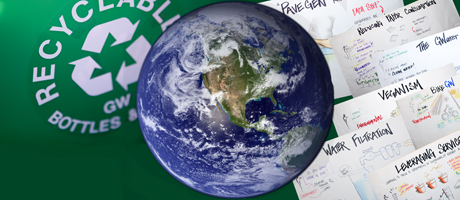By 2040, GW plans to erase its carbon footprint.
The university’s climate action plan, which was released last week, details how GW will reduce its carbon emissions by 40 percent by 2025 and reach carbon neutrality by 2040. It also emphasizes the role GW is playing in addressing climate change from an academic perspective through teaching, new research breakthroughs, and policy prescriptions.
“Achieving carbon neutrality in 30 years is an ambitious goal but one that I have no doubt we will meet,” says GW Executive Vice President and Treasurer, Lou Katz. “I’m proud that GW will be doing its part to help address climate change while making our operations more efficient.”
By making buildings more efficient, using cleaner energy and encouraging the GW community to do its part, the university will reduce its carbon emissions by at least 80 percent by 2040. The remaining carbon emissions will be mitigated through the purchase of local offsets, such as planting trees.
“First, we will work hard to reduce our carbon emissions through building improvements, smarter new construction practices and encouraging behavior changes to decrease energy use,” says Meghan Chapple-Brown, director of the Office of Sustainability.
GW began developing its climate action plan after President Knapp signed the American College and University Presidents’ Climate Commitment in 2008. GW’s climate action plan will begin to be implemented by the Green Campus Fund, a new $2 million revolving fund for sustainability that will initially improve buildings on campus, making them more energy efficient. The idea behind the Green Campus Fund is that it will be self-sustainable. The university will use the fund to improve a building’s efficiency, and then in turn will take the cost savings from those improvements and put it back into the fund to be used for future efficiency projects.
By 2040, GW plans to produce 10 percent of its energy from on-site low-carbon technologies, such as solar heated water in several residence halls. GW also intends to use alternative fuels or hybrid vehicles for its campus fleet.
“We know that we cannot solve this challenge on our own, and we’ll look for ways to use GW as a laboratory for new technology that will employ greener energy sources as well as ways we can partner with organizations to create cleaner energy sources throughout the Washington area,” says Ms. Chapple-Brown.
GW is urging students, faculty and staff to help the university reach its goal by turning off their computers and lights in the evenings, reduce use of individual electric heaters and fans and riding their bikes to campus.
GW has already made substantial efforts to make its campuses more sustainable.
In 2007, GW committed to make new construction Leadership in Energy and Environmental Design (LEED) certified. Last month, South Hall, GW’s newest residence hall, became the first university building in the District to receive LEED Gold Certification. GW’s second building built to LEED standards, Pelham Hall on the Mount Vernon Campus, will open this summer.
While the university already offers more than 130 courses and 10 certificates and degrees related to sustainability, the climate action plan, which was created by a team of internal and external experts, students, staff and faculty, calls for more course offerings in sustainability and climate change. The plan also emphasizes service-learning opportunities with a focus in sustainability.
Comments? Criticism? The conversation continues. We welcome reactions, commentary and story recommendations on our Facebook page.


